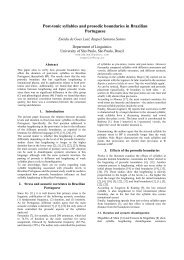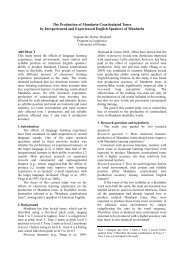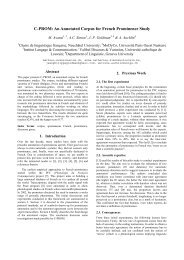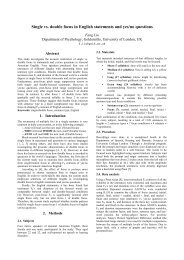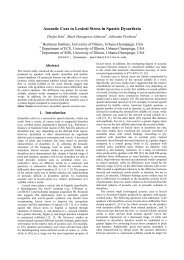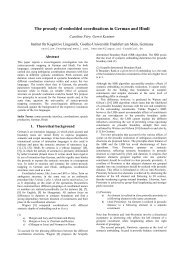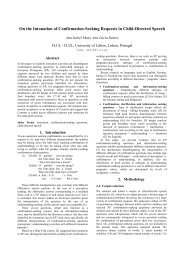Word Accent and Emotion - Speech Prosody 2010
Word Accent and Emotion - Speech Prosody 2010
Word Accent and Emotion - Speech Prosody 2010
You also want an ePaper? Increase the reach of your titles
YUMPU automatically turns print PDFs into web optimized ePapers that Google loves.
ent subsets of features, namely prosody-based, MFCC-based,<br />
<strong>and</strong> all the features together. The idea is to isolate the implicit<br />
modelling of the words/syllables induced by MFCC features.<br />
This is probably even more crucial for our data, as they consist<br />
of many mono-syllabic words: the classifier could learn the<br />
syllables that mainly fall in one specific class rather than their<br />
acoustic form. On the other side, as shown in [8], MFCC are<br />
clearly useful in emotion recognition tasks. However, as can<br />
be seen from Fig. 2, acoustic information coded in MFCC does<br />
not add up to prosodic information. One possible explanation is<br />
that, for short units like syllables <strong>and</strong> short words, prosodic phenomena<br />
(like duration or pitch rise/fall) are sharper <strong>and</strong> more<br />
consistent than on longer units like chunks or turns.<br />
normalized counts [%]<br />
normalized counts [%]<br />
14<br />
12<br />
10<br />
8<br />
6<br />
4<br />
2<br />
0<br />
0<br />
14<br />
12<br />
10<br />
8<br />
6<br />
4<br />
2<br />
0<br />
0<br />
10<br />
10<br />
20<br />
20<br />
30<br />
30<br />
syllables from ‘Aibo’ words<br />
40<br />
40<br />
50<br />
50<br />
60<br />
60<br />
syllable duration [frames]<br />
70<br />
syllables from all but ‘Aibo’ words<br />
70<br />
+WA<br />
-WA<br />
80<br />
+WA<br />
-WA<br />
Figure 4: Normalized histograms of syllable durations in frames<br />
(1 frame = 10 ms) for ‘Aibo’ words only <strong>and</strong> for all but ‘Aibo’<br />
words, for both +WA <strong>and</strong> -WA syllable durations.<br />
5. Concluding remarks<br />
There might be a simpler explanation for +WA being better than<br />
-WA: +WA syllables are generally longer, <strong>and</strong> this is probably<br />
the reason why ‘more can happen’ on these syllables, i. e. we<br />
can find more pronounced parameter values for +WA than for<br />
-WA. So we would not have to refer to emotion being – somehow<br />
– part of linguistics. On the other h<strong>and</strong>, there is of course<br />
linguistic reasons for +WA being longer <strong>and</strong> more pronounced;<br />
thus, it is not a typical chicken-<strong>and</strong>-egg problem where we do<br />
not know what came first.<br />
Note that classification performance, full coverage of the<br />
data (open-microphone setting), or feature evaluation have not<br />
been the focus of this study. Moreover, we want to stress that<br />
in this study – the same way as in any other study using realistic<br />
data – only a subset of classes can be modelled which can<br />
be subsumed under ‘appraisal of the interaction within a specific<br />
type of communication: giving comm<strong>and</strong>s to a pet robot’.<br />
80<br />
90<br />
90<br />
This means that the indication of emotion is more conscious <strong>and</strong><br />
thus, most likely, more according to linguistic structure than,<br />
e. g., when speaking in a thoroughly depressed or sad mood.<br />
Yet it has to be shown whether something like sadness really<br />
is modulated onto the speech chain in a fully global way, without<br />
taking into account linguistic structure <strong>and</strong> by that, stress<br />
patterns, at all.<br />
As mentioned above, we counterfactually assign +WA even<br />
to normally unstressed articles or other function words, following<br />
the simplistic rule ‘each mono-syllabic word carries word<br />
accent’. In our context, this means that our results are conservative<br />
because if we modelled unstressed mono-syllabic words<br />
as well, most likely the differences would have been even more<br />
pronounced. This holds for the word level. Apparently, words<br />
carrying the phrase accent are as well more pronounced than<br />
words that do not: this is well known from studies on (semantic)<br />
salience. The same way, such words might be ‘emotionally<br />
prominent’ <strong>and</strong> thus, better c<strong>and</strong>idates for emotion classification<br />
than non-salient words.<br />
6. Acknowledgements<br />
This research has received funding from the European Community under<br />
grant No. RTN-CT-2006-035561 (S2S), No. IST-2001-37599 (PF-<br />
STAR), No. IST-2002-50742 (HUMAINE), <strong>and</strong> No. FP7-2007-211486<br />
(SEMAINE). The responsibility lies with the authors.<br />
7. References<br />
[1] B. Schuller, A. Batliner, S. Steidl, <strong>and</strong> D. Seppi, “<strong>Emotion</strong> Recognition<br />
from <strong>Speech</strong>: Putting ASR in the Loop,” in Proc. of<br />
ICASSP, Taipei, 2009, pp. 4585–4588.<br />
[2] A. Batliner, S. Steidl, C. Hacker, <strong>and</strong> E. Nöth, “Private emotions<br />
vs. social interaction — a data-driven approach towards analysing<br />
emotions in speech,” User Modeling <strong>and</strong> User-Adapted Interaction,<br />
vol. 18, pp. 175–206, 2008.<br />
[3] S. Steidl, Automatic Classification of <strong>Emotion</strong>-Related User<br />
States in Spontaneous Children’s <strong>Speech</strong>. Berlin: Logos Verlag,<br />
2009, PhD thesis.<br />
[4] M. Shami <strong>and</strong> W. Verhelst, “Automatic Classification of Expressiveness<br />
in <strong>Speech</strong>: A Multi-corpus Study,” in Speaker Classification<br />
II, C. Müller, Ed. Berlin: Springer, 2007, pp. 43–56.<br />
[5] B. Schuller, M. Wimmer, L. Mösenlechner, C. Kern, D. Arsic,<br />
<strong>and</strong> G. Rigoll, “Brute-Forcing Hierarchical Functionals for Paralinguistics:<br />
a Waste of Feature Space?” in Proc. of ICASSP, Las<br />
Vegas, 2008, pp. 4501–4504.<br />
[6] T. Vogt <strong>and</strong> E. André, “Comparing feature sets for acted <strong>and</strong><br />
spontaneous speech in view of automatic emotion recognition,”<br />
in Proc. of ICME, Amsterdam, 2005, pp. 474–477.<br />
[7] K. Demuynck, J. Roelens, D. V. Compernolle, <strong>and</strong> P. Wambacq,<br />
“SPRAAK : an open source ‘SPeech Recognition <strong>and</strong> Automatic<br />
Annotation Kit’,” in Proc. of Interspeech, Brisbane, 2008, pp.<br />
495–499.<br />
[8] B. Schuller, A. Batliner, D. Seppi, S. Steidl, T. Vogt, J. Wagner,<br />
L. Devillers, L. Vidrascu, N. Amir, L. Kessous, <strong>and</strong> V. Aharonson,<br />
“The Relevance of Feature Type for the Automatic Classification<br />
of <strong>Emotion</strong>al User States: Low Level Descriptors <strong>and</strong> Functionals,”<br />
in Proc. of Interspeech, Antwerp, 2007, pp. 2253–2256.<br />
[9] F. Eyben, M. Wöllmer, <strong>and</strong> B. Schuller, “openEAR - Introducing<br />
the Munich Open-Source <strong>Emotion</strong> <strong>and</strong> Affect Recognition<br />
Toolkit,” in Proc. of ACII, Amsterdam, 2009, pp. 576–581.<br />
[10] I. H. Witten <strong>and</strong> E. Frank, Data mining: Practical machine learning<br />
tools <strong>and</strong> techniques, 2nd ed. San Francisco: Morgan Kaufmann,<br />
2005.<br />
[11] B. Efron <strong>and</strong> R. J. Tibshirani, An Introduction to the Bootstrap.<br />
New York: Chapman & Hall, 1993.<br />
[12] K. Pike, The intonation of American English. Ann Arbor, Michigan:<br />
University of Michigan Press, 1945.



